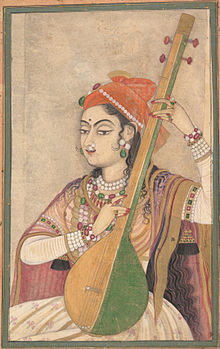Odissi music
| Music of India | |
|---|---|

A Lady Playing the Tanpura, ca. 1735 (Rajasthan)
|
|
| Genres | |
|
|
| Media and performance | |
| Music awards | |
| Music festivals | |
| Music media | |
| Nationalistic and patriotic songs | |
| National anthem | Jana Gana Mana |
| Regional music | |
|
|
Odissi music (oṛiśī) is a genre of classical music in India originated from the eastern state of Odisha. Indian classical music has five significant branches: Avanti, Panchali, Odramagadhi, Hindustani and Carnatic. Of these, Odramagadhi exists in the form of Odissi music. Generally, Odissi is one of the classical dances of India performed with Odissi music. Odissi music was shaped during the time of Oriya poet Jayadeva, who composed lyrics meant to be sung. By the 11th century AD, folk music of Odisha in the form of Triswari, Chatuhswari, and Panchaswari was modified into the classical style. However, Odissi songs were written even before the Oriya language developed. Odissi music has a rich legacy dating back to the 2nd century BCE, when king Kharvela, the ruler of Odisha (Kalinga), patronized this music and dance.
Ancient Odisha had a rich culture of music, which is substantiated by many archaeological excavation throughout Odisha. At Sankarjung in the Angul district, the initial spade work exposed the cultural stratum of the Chalcolitic period. From here, polished stone celts and hand-made pottery have been excavated. Some of the Celts are narrow but large in size. Thus they are described as Bar-celts. On the basis of bar-celts discovered in Sankarjung it could be argued that they were an earlier musical instrument in India. There is historical evidence in the form of sculptural evidence, i.e. musical instruments, singing and dancing postures of damsels in the Ranigumpha Caves in Khandagiri and Udayagiri at Bhubaneswar.
Charya Geetika (poems of Buddhist literature), written between 7th to 12th century mostly by the poets of Odisha and Bengal, are connected with Tantric Buddhism. All India literature on music like Bharat Muni's Natya Shastra, written in 2nd to 4th century AD., referred to the Odra Magadhi style of music and dance, which belonged to Odisha. Similarly, Sangeet Ratnakar also had a reference to the Odra Magadhi style of music. There are certain texts on Odissi music which are authentic and authoritative, and are excellent indices to the development of the music. These are written in Sanskrit or Oriya and contain the characteristics of Udramagadhi, Ardhamagadhi, Udra Bhasa and Utkalika Bibhasa. These were Oriya Charyagitika by different Oriya Sidhacharyas in the 7th to 11th centuries, Gita Govinda by Sri Jayadeva in the 12th century, Sangita Sara by Hari Nayak in the 14th century to 15th century, Rasavaridhi by Brundavan Das in the 15th century, Oriya Mahabharata by Sarala Das in the 15th century, Rasakallola by Dinakrushna Das in the 16th century, etc. Other books written in later years were Sangita Darpana, Sangit Kalpadruma, Sangitarnava Chandrika, Baidehisha Vilash, etc. It proves that Odissi music is more ancient than its counterparts like Hindustani or Carnatic
...
Wikipedia
